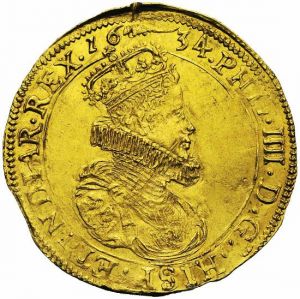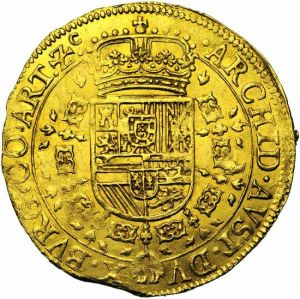Artois 1634 2 souverain d'or Fr-26c
This specimen was lot 699 in Jean Elsen sale 115 (Brussels, December 2012) where it sold for €12000 (about US$18,316 including buyer's fees). The catalog description[1] noted,
"ARTOIS, Comté, Philippe IV (1621-1640), AV double souverain, 1634, Arras. Premier type. Droit : B. cuirassé et couronné à droite, une grande fraise au col. Revers : Ecu couronné, entouré du collier de la Toison d'or. De la plus haute rareté. Griffes au droit. Ex HSA 57.2161. presque Superbe. (county of Artois, Philip IV (1621-40), gold double souverain of 1634, Arras mint, first type. Obverse: crowned and armored bust to right with large ruffed collar; reverse: crowned arms, Order of the Golden Fleece around. Of the highest rarity, scratches on obverse, about extremely fine.)
Les dernières monnaies d'or et d'argent sous souveraineté espagnole en Artois furent frappées en 1640. Arras, défendue par dix mille hommes commandés par le colonel O'Neill, fut assiégée par deux corps d'armée français, commandés par le maréchal de Châtillon et le maréchal de Chaulnes, et deux corps d'armée des Provinces-Unies, commandés par le duc de la Meilleraye et par Frédéric-Henri d'Orange-Nassau. Le siège commença le 13 juin 1640. Une armée espagnole de vingt mille hommes et douze mille cavaliers, commandés par Ferdinand d'Autriche, vint camper sur le Mont-Saint-Eloi, à quelques kilomètres d'Arras, dans le but de couper les vivres aux assaillants. Mais ce plan échoua. Arras capitula le 8 août 1640 et passa à la France. Louis XIII y nomma le duc de Chaulnes gouverneur. L'atelier monétaire fut maintenu ouvert pour y frapper les types royaux, écus d'or, demi-francs, quarts et huitièmes d'écu. Durant le printemps 1641 et jusqu'en septembre 1641, les places fortes espagnoles d'Aire-sur-la-Lys, Lens, Bapaume et La Bassée furent également prises par les troupes de Richelieu, qui à la fin de 1641 contrôlaient l'Artois tout entier. La paix des Pyrénées (1659) mit fin à trente ans de guerre entre la France et l'Espagne et réunit définitivement l'Artois à la France. (The last gold and silver coins of Spanish rule in Artois were struck in 1640. Arras, defended by ten thousand men commanded by Col. O'Neill, was besieged by two corps of the French army, commanded by Marshal Châtillon and Marshal Chaulnes, and two corps of the army of the United Provinces, commanded by the duke of la Meilleraye and Frederick Henry, prince of Orange. The siege commenced June 13, 1640. A Spanish army of twenty thousand men and twelve thousand cavalry, commanded by Ferdinand of Austria, was encamped on Mont-Saint-Eloi, some kilometers away, to break the siege, but the plan failed. Arras surrendered August 8, 1640, and passed to France. Louis XIII named the duke of Chaulnes governor. The mint remained open to strike French royal types such as écus d'or, half francs, quarter and eighth écus. During the spring of 1641 and until September 1641, the Spanish strongpoints Aire-sur-la-Lys, Lens, Bapaume and La Bassée were also captured by the troops of Richelieu, who by the end of 1641 controlled all of Artois. The Peace of the Pyrénées (1659) ended thirty years of war between France and Spain and permanently attached Artois to France.)"
This type is listed for Flanders, Tournai and Brabant but is nowhere common.
Recorded mintage: unknown.
Specification: 11.06 g, .919 fine gold (incorrectly noted as 22.12 g in the SCWC); this specimen is 11,09 g.
Catalog reference: G.H., 324-7; Delm-33; Dewismes, 261, Fr-26c (listed under France), KM 15.
- Friedberg, Arthur L. and Ira S. Friedberg, Gold Coins of the World, From Ancient Times to the Present, 9th ed., Clifton, NJ: Coin and Currency Institute, 2017.
- [1]Elsen, Philippe, et al., Vente Publique 115: Collection Huntington, Brussels: Jean Elsen et ses Fils, S.A., 2012.
Link to:

